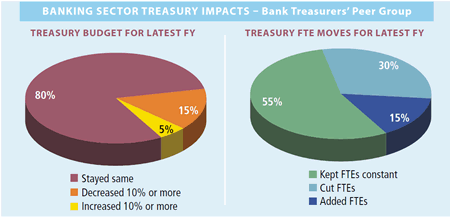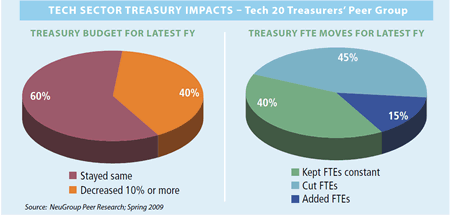Treasury Escapes the Ax (Relatively Speaking)
By Joseph Neu
As has been noted frequently in International Treasurer, the silver lining in the financial crisis for treasury is that it has put a spotlight on its importance in keeping firms viable—i.e., funded, liquid and on top of market volatility—during tough conditions. Unfortunately, being in the limelight only helps so much.
Evidence from recent NeuGroup peer group meetings point to CFOs giving treasurers stays on cuts at best, but no overwhelming increases to either budgets or staff (see charts below). Thus, doing more with the same, if not less, remains the mantra for treasury despite the vital importance of treasury validated by recent months of crisis.



HOW CENTRALIZED AND EFFICIENT?
Indeed, where FTEs have been added it is usually in circumstances where growing companies are creating modern treasuries for the first time. Firms that have developed treasury organizations have also been in the processes of centralizing and wringing efficiencies out of treasury, for years, if not decades leading up to the crisis.
-
Centralization a given. A recent survey of finance executives by McKinsey (see sidebar below) confirmed that treasury is the most centralized of finance area activities: 70 percent of respondents said that Treasury was fully centralized, followed by Internal Audit (65 percent) and Tax (62 percent). These findings are consistent with those of the NeuGroup’s 2008 Key Indicator Survey, where respondents rated their treasury centralization on average 7.9 on a scale of 1 to 10. In most cases, treasury is centralized at corporate headquarters: with, on average, 83 percent of core treasury FTEs at HQ.
|
HOW FINANCE FUNCTIONS ARE CHANGING A global survey by McKinsey consultants, published in the April The McKinsey Quarterly, points to how finance functions are changing in response to the crisis.
The most likely response to the crisis to hold constant is a continuous effort to reduce costs.
Finally, in McKinsey’s view, CFOs will need to improve their ability to add value in risk and strategy, with more involvement from business functions and a change in governance to make this work better. |
Centralization at HQ, however, may be a trend challenged by further cost-cutting efforts, especially where corporate headquarters are found in high-cost locations.
-
Headcount never too low. Treasury functions are typically lean, though some functions are leaner than others. The NeuGroup’s survey of its peer group companies last year indicated a range of 0.27 FTEs per billion in revenue to 22 per billion. This suggests either that some firms are more efficient in running their treasuries than others, or some businesses call for more human treasury support. The bulk of treasury headcount appears to lie outside mission-critical areas like capital markets activities (2.94 FTEs on average); capital structure/corporate finance analysis (2.25 FTEs on average); FX (2.41 FTEs) or credit risk (1.76).
Still, if you consider that NeuGroup peer companies have on average 8 core treasury FTEs for cash and liquidity management worldwide, and perhaps another 6.6 FTEs for related treasury operations, there’s but little fat to cut here either.
-
Treasury operations to be targeted. Yet, cost cutting and further drives for efficiency continue to be the CFO reality. The CFO of one NeuGroup member company noted that further reductions in cost and eventually headcount will continue to be sought, principally in the treasury operations areas.
One way to cut costs is by moving treasury operations out of HQ to low-cost countries and parts of the US. This is consistent with the recent wave of shared service center and related treasury back-office centers that have been a part of MNC treasury initiatives over the last few years.
Senior treasury staff are wanted close at hand, so CFOs are unlikely to push for the entire treasury function to be re-centralized in low-cost jurisdictions. Also, treasury talent at senior levels is still in short enough supply that the jurisdictional differences don’t factor in as much.
However, US MNCs concerned about changes in taxation of offshore earnings may just off-shore their HQs, with treasury providing some of the substance.
-
Best-in-class delays the ax. Finally, what seems to be the key conclusion about treasury’s relative position among corporate functions is that it is its relative performance advantage against world-class benchmarks and not the limelight of the crisis that matters to CFOs
“Part of what drives the priority of cost reductions,” one CFO indicated, “is the extent to which functions are not meeting best-in-class benchmarks. As treasury is already best in class [at our company], reductions are more likely to come through attrition relative to other finance areas.“
This helps explain the drive by many treasury departments currently to redefine “world-class” benchmarks against which they are measured, so they can maintain their relative advantage or even seek some absolute gains. The recent crisis has resulted in a major workload increase for many treasury professionals, and this additional work has not won them further compensation.
They’d like this to change.
|
TREASURY COMP TRENDS “The bad news is that there will be no raises this year; the good news is that you still have a job.” This comment from a treasurer on what he told his staff pretty much sums up the prevailing view on treasury compensation trends. At the margins, some firms are even cutting base pay on the downside, but offering the prospect of bonuses on the upside. In industries where equity compensation is still common, staff is being offered equity (at crisis-induced lows). SOME BENCHMARKS These data points from The 2008 NeuGroup Key Indicator Survey can thus be adjusted in light of the above trends. Indicative comp: Average comp mix responses for senior/junior treasury staff: |